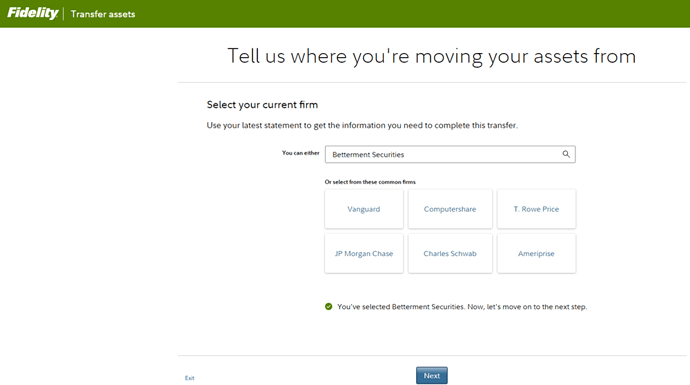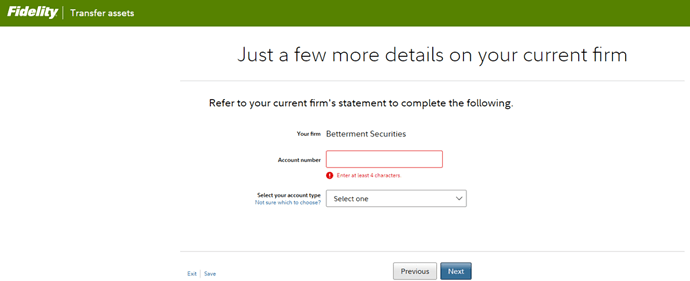Betterment is a good choice if you’re just starting out with investing. They make it easy for beginners to get started. However, as your portfolio grows, you might find that it makes more sense to switch to Fidelity.
Fidelity is a well-known and respected investment firm that has been around for decades. They even have zero expense funds to help you save money on management fees.
By transferring from Betterment to Fidelity, you get access to better investment options. Lastly, rest assured that customer service is always available 24/7 to help.
Follow the instructions below to get started.
How to Transfer from Betterment to Fidelity
Step 1: Create an account with Fidelity.
Step 2: Visit the Transfer of Assets page.
Step 3: Select Betterment Securities as your current brokerage.

Step 4: Enter your Betterment account number. You can find this information in your Betterment account statement.
Step 5: Select your account type from the drop-down.

Step 6: Click Next.
Continue with the on-screen instructions and submit your request.
Once Fidelity receives your request, they will initiate an ACAT transfer with Betterment. Fidelity will help you move your assets over. No further action is required.
How long does it take to transfer from Betterment to Fidelity?
On average, it takes about 3-5 days to transfer your investments from Betterment to Fidelity. It may take longer (up to 2 weeks) depending on the complexity of your account.
While you wait, use the Transfer Tracker tool to check your account status.
How much does it cost to transfer out of Betterment?
Betterment does not charge any fee for outgoing ACAT transfer or close out your current account. Therefore, it cost nothing!
💬 Community Discussion
Matt W:
I used Betterment for a few years and transferred everything out to Fidelity. They have great tools, portfolio rebalancing, and tax efficiency, but it’s almost impossible to leave once you join. Betterment invest in far too many ETFs. In my opinion, just stay with Fidelity.
Malcolm G:
The biggest upside to platforms like Betterment or Wealthfront is automated tax-loss harvesting. It’s something you can do yourself, but it involves some effort.
- Remember to sell off portions of securities at a loss.
- Remember which securities not to purchase for 30 days after selling them to avoid a wash sale.
- Select similar but not identical funds to buy within that 30-day window.
I have a system for 2 & 3, but I typically rarely think about step 1!
Erik A:
Betterment is a robo-advisor. I don’t see the value-add in such service. You basically pay for Betterment to pick investments and rebalance your portfolio. Things that you can easily do yourself for free.
1 post – 1 participant

